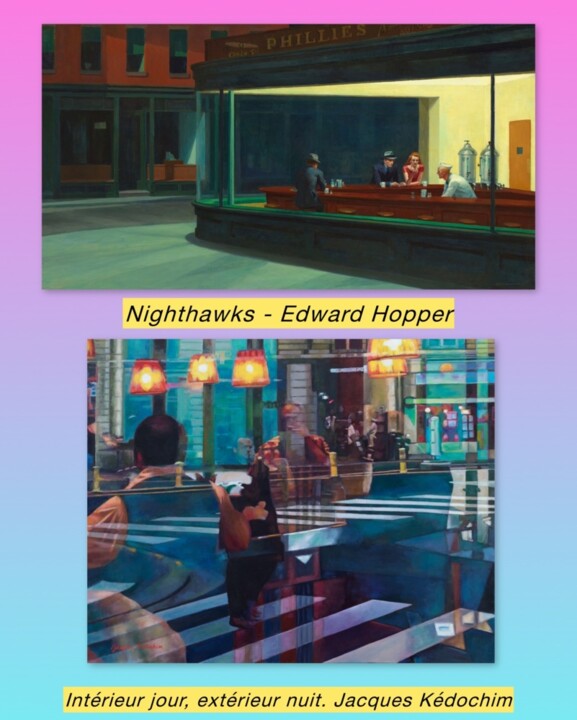 During my exhibitions, my Urban Reflections are often compared to the paintings of Edward Hopper — a remark that, for quite some time, used to surprise me. At first glance, our pictorial worlds seem far apart.
During my exhibitions, my Urban Reflections are often compared to the paintings of Edward Hopper — a remark that, for quite some time, used to surprise me. At first glance, our pictorial worlds seem far apart.
My palette is vivid and saturated with color, while Hopper’s remains restrained, sometimes almost austere. Where he explored urban architecture with geometric precision, I approach the city through the distorting prism of Parisian shop windows: fractured perspectives, fragmented images, overlapping planes, and vibrant hues transform the city into a kind of kaleidoscope.
And yet, there is something essential and universal that connects my work to his.
Hopper and the Cinema
In Hopper’s world, the city becomes a stage — at times cold, but always charged with silent intensity. One immediately thinks of Nighthawks, that iconic New York diner plunged into the night: artificial light isolates the figures, the composition has the rigor of a film frame, and the viewer feels suspended in a moment poised between stillness and narrative.
Perhaps this is where our kinship lies: in that search for a visual dramaturgy, where painting becomes a screen, and urban solitude is expressed as much through light as through space.
Contemporary Solitude
Hopper often placed his figures in spaces too vast for them, as if engulfed by an indifferent architecture. They are present, yet unreachable — frozen in a bubble of silence.
In my Urban Reflections, solitude takes another form: that of passersby fragmented, of ghostly faces and silhouettes fractured by the refraction of light. The urban space is dense, saturated with signs, yet each figure remains alone, confronted by their own image.
Gauguin and the Power of Color
If Hopper inspires me through atmosphere, Paul Gauguin teaches me the expressive force of color. His bold, intense harmonies transfigure reality, giving it an inner, almost spiritual dimension.
In my paintings, I strive to preserve this idea : that color is not merely there to fill form, but to speak — to carry emotion, to open a sensory space where the viewer can enter and feel.
Delaunay and the Vibration of Light
At the opposite end of Hopper’s austerity, Robert Delaunay offered me another inheritance : that of rhythm, of a painting in motion, where color becomes light and energy. His circles, contrasts, and chromatic pulses give the impression that the canvas breathes.
In my Urban Reflections, the shop windows play a similar role: they fragment space, refract light, make color vibrate.
They turn the city into a living composition, almost musical.
Between Silence and Radiance
From Hopper, I have retained the visual dramaturgy and the evocation of contemporary solitude.
From Gauguin, I have learned to let color take the leading role — to let it become its own language.
From Delaunay, I have inherited a love of rhythmic color, capable of making the surface itself come alive.
Between silence and radiance, solitude and vibration, my Urban Reflections exist within this dialogue and attempt, in my own way, to carry forward what each of them explored : light, color, and the human condition within the urban space.